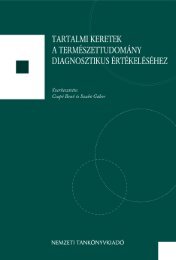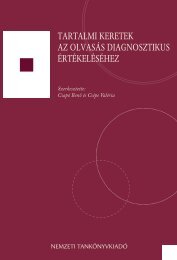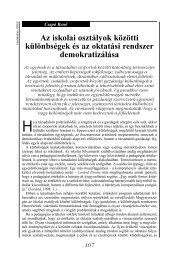értekezés - Neveléstudományi Intézet - Szegedi Tudományegyetem
értekezés - Neveléstudományi Intézet - Szegedi Tudományegyetem
értekezés - Neveléstudományi Intézet - Szegedi Tudományegyetem
Create successful ePaper yourself
Turn your PDF publications into a flip-book with our unique Google optimized e-Paper software.
Bultzlaff, (2000): Can music be used to teach reading? Journal of Aesthetic Education, 34. 3–<br />
4 sz. 167–178.<br />
Carlton, M. P. és Winsler, A. (1998): Fostering intrinsic motivation in early childhood<br />
classrooms. Early Childhood Education Journal, 25. 3. sz. 159–166.<br />
Carroll, J. B. (1993): Human Cognitive Abilities: A Survey of Factor-Analytical Studies.<br />
Cambrige University Press, New York.<br />
Carroll, J. B. (1996): A matematikai képességek: a faktoranalitikus módszer néhány eredménye.<br />
In: Sternberg, R. J. és Ben-Zeev, T. (szerk.): A matematikai gondolkodás természete.<br />
Vince Kiadó, Budapest. 15–37.<br />
Cattell, R. B. és Horn, J. L. (1978): A chek on the theory of fluid and crystallized intelligence<br />
with description of new subtest designs. Journal of Educational Measurement, 15. 3. sz.<br />
139–164.<br />
Chan, A. S. Ho, Y. és Cheung, M. (1998): Music training improves verbal memory. Nature,<br />
396. 12. sz. 128.<br />
Chang, H. W. és Trehub, S. E. (1977): Auditory processing of relational information by<br />
young infants. Journal of Experimental Child Psychology, 24. 324–331.<br />
Cheek, J. M. és Smith, L. R. (1999): Music training and mathematics achievement.<br />
Adolescence, 34. 759–762.<br />
Chomsky, N. (1995): Mondattani szerkezetek. Nyelv és elme. Osiris Kiadó, Budapest.<br />
Chrappán Magdolna (2008): A tevékenységközpontú óvodai program pedagógiai és pszichológiai<br />
háttere. In: Hovánszki Jánosné (szerk.): Zenei nevelés az óvodában. Szöveggyőjtemény.<br />
Didakt Kiadó, Debrecen. 247–255.<br />
Coley, R. J. (2001): Differences in the gender gap: Comparisons across racial/ethnic groups in<br />
education and work. Policy Information Report (Educational Testing Service, Research<br />
Division, Policy Information Center, Princeton) 1–54.<br />
Colwell, R. (1969): Music Achievement Test, Interpretive Manual. Follett Educational Corporation,<br />
Chicago.<br />
Costa-Giomi, E. (1994): Recognition of chord changes by 4- and 5-year-old American and<br />
Argentine children. Journal of Research in Music Education, 42. 1. sz. 68–85.<br />
Costa-Giomi, E. (1999): The effect of three years of piano instruction on children’s cognitive<br />
development. Journal of Research in Music Education, 47. 5. sz. 198–212.<br />
Cropley, A. J. (2001): Creativity in Education and Learning. Kogan Page, London – Stylus<br />
Publishing, Sterling.<br />
Crowder, R. G., Reznick, J. S. és Rosenkrantz, S. L. (1991): Perception of the major/minor<br />
distinction: V. Preferences among infants. Bulletin of the Psychonomic Society, 29. 187–<br />
188.<br />
Cuddy, L. L. Cohen, A. J. és Mewhort, D. J. K. (1981): Perception of structure in short<br />
melodic sequences. Journal of Experimental Psychology: Human Perception &<br />
Performance, 7. 869–883.<br />
Csapó Benı (1987): A kritérium-orientált értékelés. Magyar Pedagógia, 87. 3. sz. 247–266.<br />
Csapó Benı (1988): A kombinatív képesség struktúrája és fejlıdése. Akadémiai Kiadó, Budapest.<br />
Csapó Benı (1994): Az induktív gondolkodás fejlıdése. Magyar Pedagógia, 94. 1–2. sz. 53–<br />
80.<br />
282



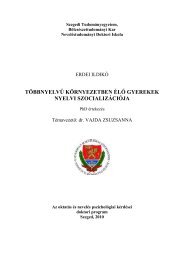

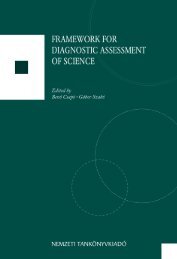
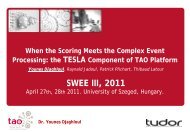
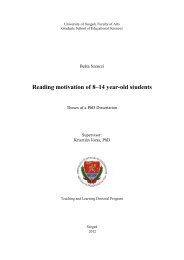

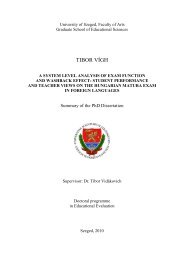
![Download [PDF] - Diagnosztikus Mérések Fejlesztése](https://img.yumpu.com/38928685/1/177x260/download-pdf-diagnosztikus-macracsek-fejlesztacse.jpg?quality=85)
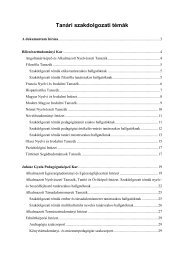


![Download [PDF] - Diagnosztikus Mérések Fejlesztése](https://img.yumpu.com/38928622/1/180x260/download-pdf-diagnosztikus-macracsek-fejlesztacse.jpg?quality=85)
